Global & International Business: Indonesia Fashion Industry Analysis
VerifiedAdded on 2023/06/10
|18
|6302
|437
Report
AI Summary
This report provides an analysis of the Indonesian fashion industry, utilizing Porter's Diamond model to understand the nation's competitive advantages and the role of foreign direct investment (FDI) in its growth. It highlights Indonesia's rapidly improving economic conditions, making it an attractive destination for FDI, particularly in the fashion sector, which has seen significant investment inflows over the past decade. While China remains a strong competitor, the report examines the factors influencing Indonesia's fashion industry, including government policies, factor conditions, firm strategies, demand conditions, and related industries. It also explores market entry strategies such as joint ventures and wholly-owned subsidiaries, weighing their advantages and disadvantages. The report concludes by identifying key managerial issues that foreign companies must address when entering the Indonesian fashion market, related to both Porter's Diamond model and FDI considerations.
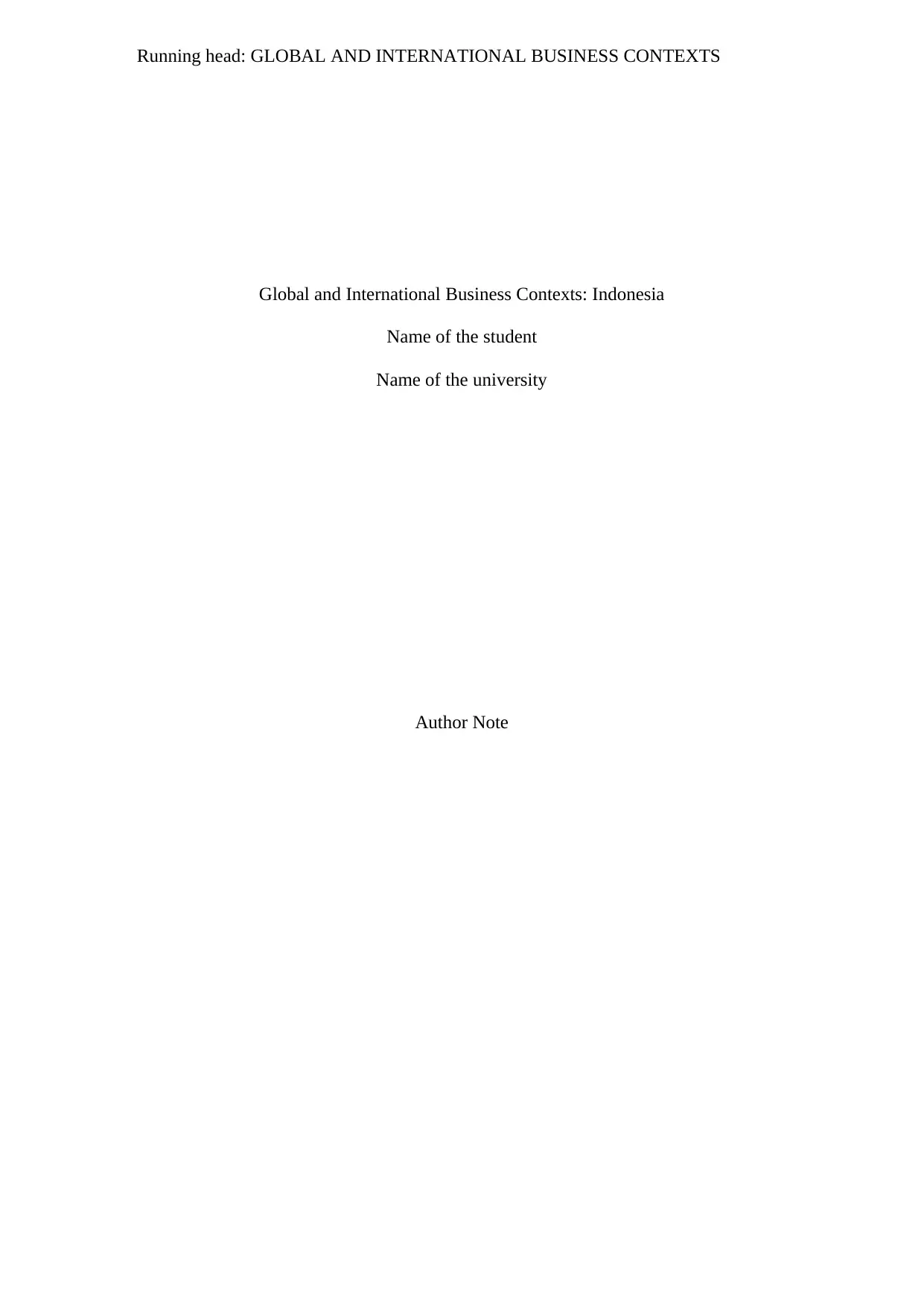
Running head: GLOBAL AND INTERNATIONAL BUSINESS CONTEXTS
Global and International Business Contexts: Indonesia
Name of the student
Name of the university
Author Note
Global and International Business Contexts: Indonesia
Name of the student
Name of the university
Author Note
Paraphrase This Document
Need a fresh take? Get an instant paraphrase of this document with our AI Paraphraser
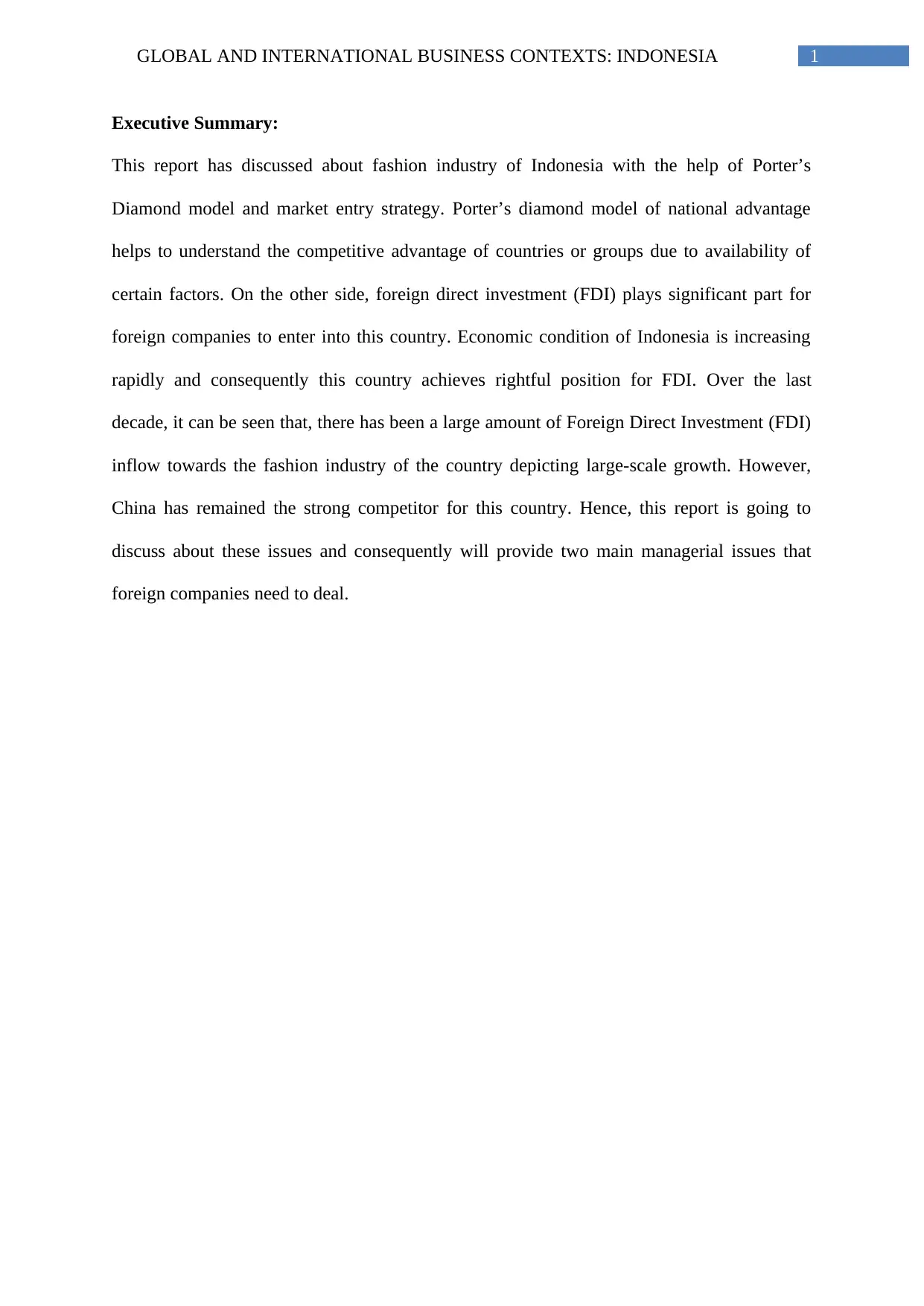
1GLOBAL AND INTERNATIONAL BUSINESS CONTEXTS: INDONESIA
Executive Summary:
This report has discussed about fashion industry of Indonesia with the help of Porter’s
Diamond model and market entry strategy. Porter’s diamond model of national advantage
helps to understand the competitive advantage of countries or groups due to availability of
certain factors. On the other side, foreign direct investment (FDI) plays significant part for
foreign companies to enter into this country. Economic condition of Indonesia is increasing
rapidly and consequently this country achieves rightful position for FDI. Over the last
decade, it can be seen that, there has been a large amount of Foreign Direct Investment (FDI)
inflow towards the fashion industry of the country depicting large-scale growth. However,
China has remained the strong competitor for this country. Hence, this report is going to
discuss about these issues and consequently will provide two main managerial issues that
foreign companies need to deal.
Executive Summary:
This report has discussed about fashion industry of Indonesia with the help of Porter’s
Diamond model and market entry strategy. Porter’s diamond model of national advantage
helps to understand the competitive advantage of countries or groups due to availability of
certain factors. On the other side, foreign direct investment (FDI) plays significant part for
foreign companies to enter into this country. Economic condition of Indonesia is increasing
rapidly and consequently this country achieves rightful position for FDI. Over the last
decade, it can be seen that, there has been a large amount of Foreign Direct Investment (FDI)
inflow towards the fashion industry of the country depicting large-scale growth. However,
China has remained the strong competitor for this country. Hence, this report is going to
discuss about these issues and consequently will provide two main managerial issues that
foreign companies need to deal.
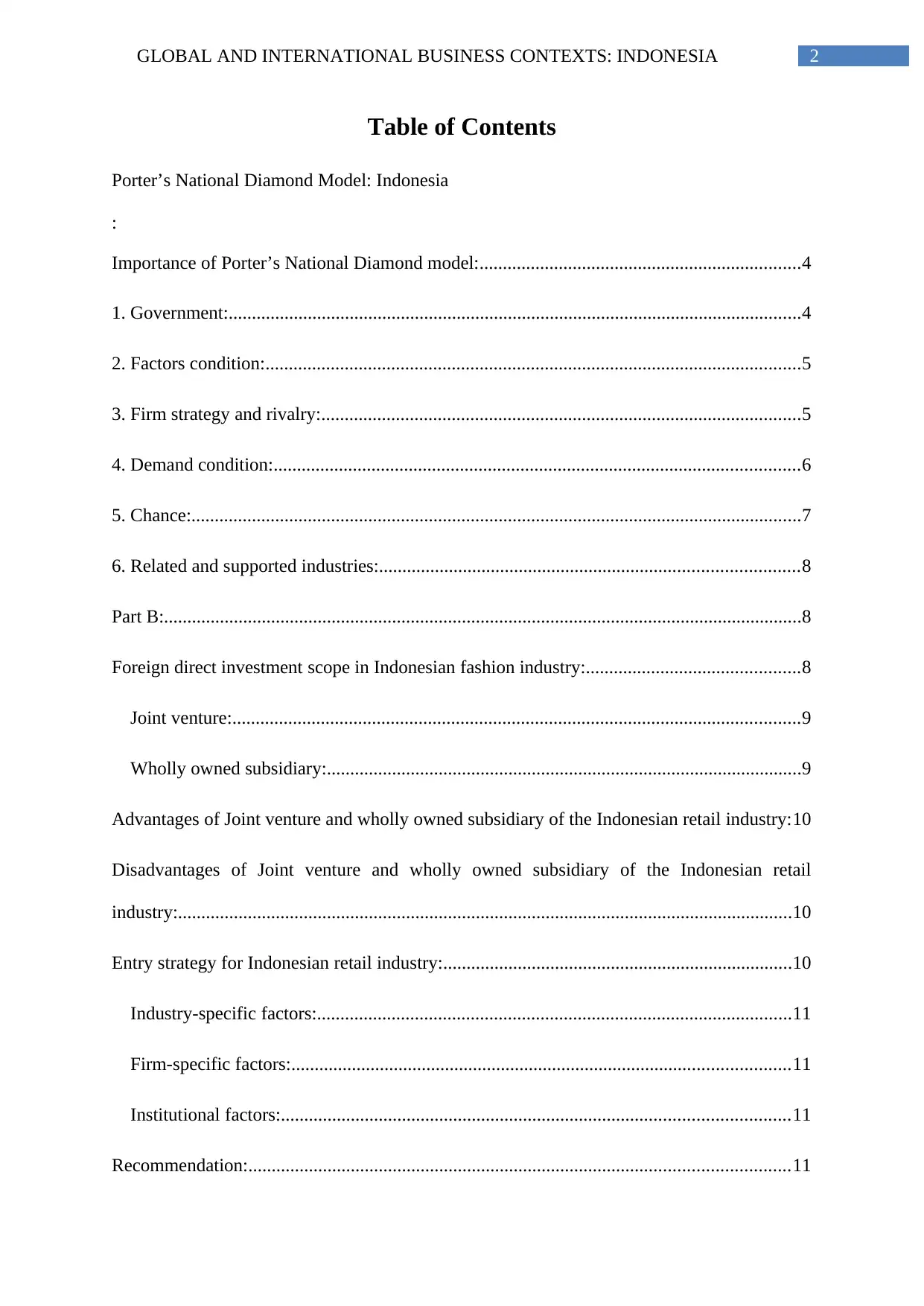
2GLOBAL AND INTERNATIONAL BUSINESS CONTEXTS: INDONESIA
Table of Contents
Porter’s National Diamond Model: Indonesia
:
Importance of Porter’s National Diamond model:.....................................................................4
1. Government:...........................................................................................................................4
2. Factors condition:...................................................................................................................5
3. Firm strategy and rivalry:.......................................................................................................5
4. Demand condition:.................................................................................................................6
5. Chance:...................................................................................................................................7
6. Related and supported industries:..........................................................................................8
Part B:.........................................................................................................................................8
Foreign direct investment scope in Indonesian fashion industry:..............................................8
Joint venture:..........................................................................................................................9
Wholly owned subsidiary:......................................................................................................9
Advantages of Joint venture and wholly owned subsidiary of the Indonesian retail industry:10
Disadvantages of Joint venture and wholly owned subsidiary of the Indonesian retail
industry:....................................................................................................................................10
Entry strategy for Indonesian retail industry:...........................................................................10
Industry-specific factors:......................................................................................................11
Firm-specific factors:...........................................................................................................11
Institutional factors:.............................................................................................................11
Recommendation:....................................................................................................................11
Table of Contents
Porter’s National Diamond Model: Indonesia
:
Importance of Porter’s National Diamond model:.....................................................................4
1. Government:...........................................................................................................................4
2. Factors condition:...................................................................................................................5
3. Firm strategy and rivalry:.......................................................................................................5
4. Demand condition:.................................................................................................................6
5. Chance:...................................................................................................................................7
6. Related and supported industries:..........................................................................................8
Part B:.........................................................................................................................................8
Foreign direct investment scope in Indonesian fashion industry:..............................................8
Joint venture:..........................................................................................................................9
Wholly owned subsidiary:......................................................................................................9
Advantages of Joint venture and wholly owned subsidiary of the Indonesian retail industry:10
Disadvantages of Joint venture and wholly owned subsidiary of the Indonesian retail
industry:....................................................................................................................................10
Entry strategy for Indonesian retail industry:...........................................................................10
Industry-specific factors:......................................................................................................11
Firm-specific factors:...........................................................................................................11
Institutional factors:.............................................................................................................11
Recommendation:....................................................................................................................11
⊘ This is a preview!⊘
Do you want full access?
Subscribe today to unlock all pages.

Trusted by 1+ million students worldwide
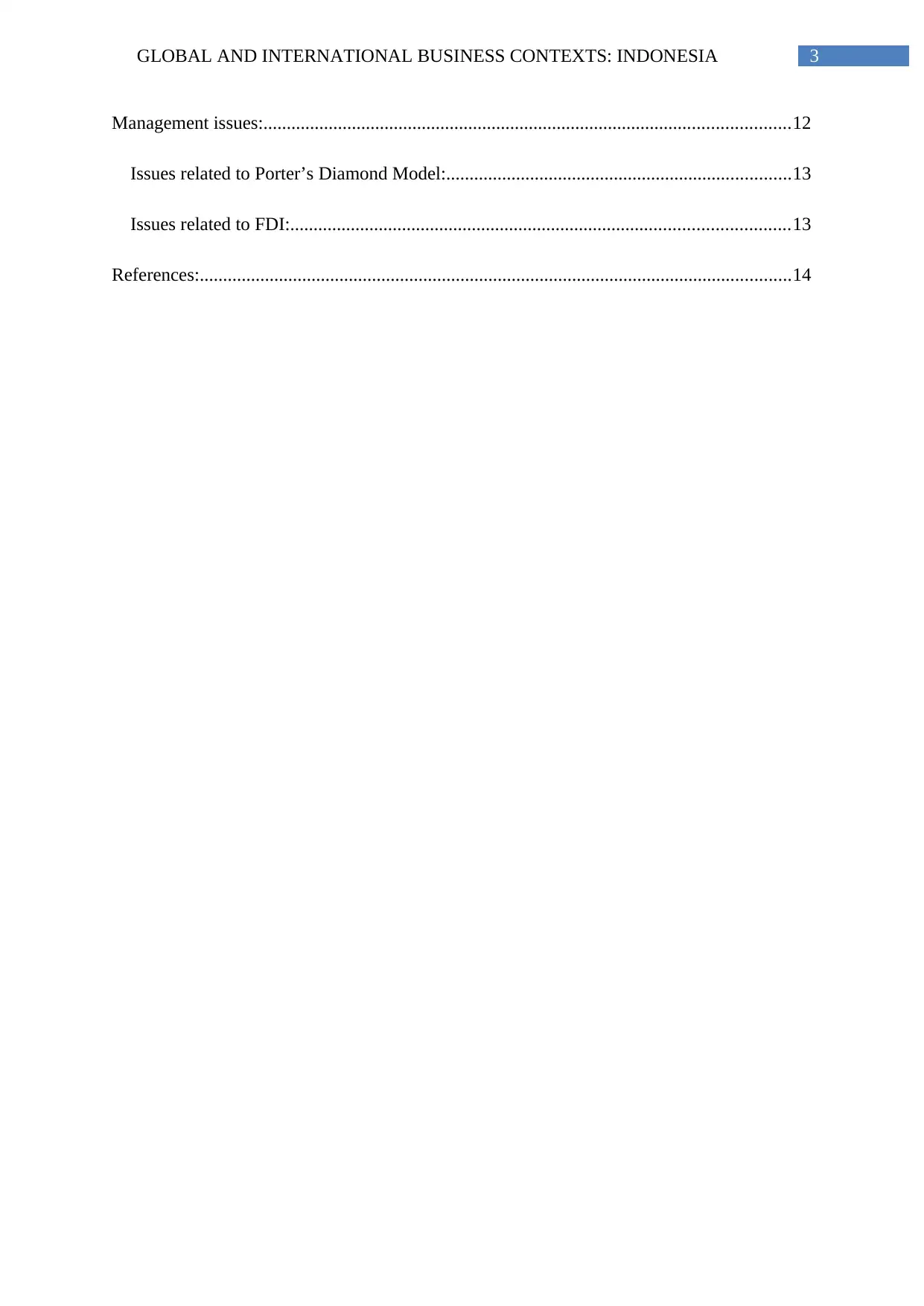
3GLOBAL AND INTERNATIONAL BUSINESS CONTEXTS: INDONESIA
Management issues:.................................................................................................................12
Issues related to Porter’s Diamond Model:..........................................................................13
Issues related to FDI:...........................................................................................................13
References:...............................................................................................................................14
Management issues:.................................................................................................................12
Issues related to Porter’s Diamond Model:..........................................................................13
Issues related to FDI:...........................................................................................................13
References:...............................................................................................................................14
Paraphrase This Document
Need a fresh take? Get an instant paraphrase of this document with our AI Paraphraser
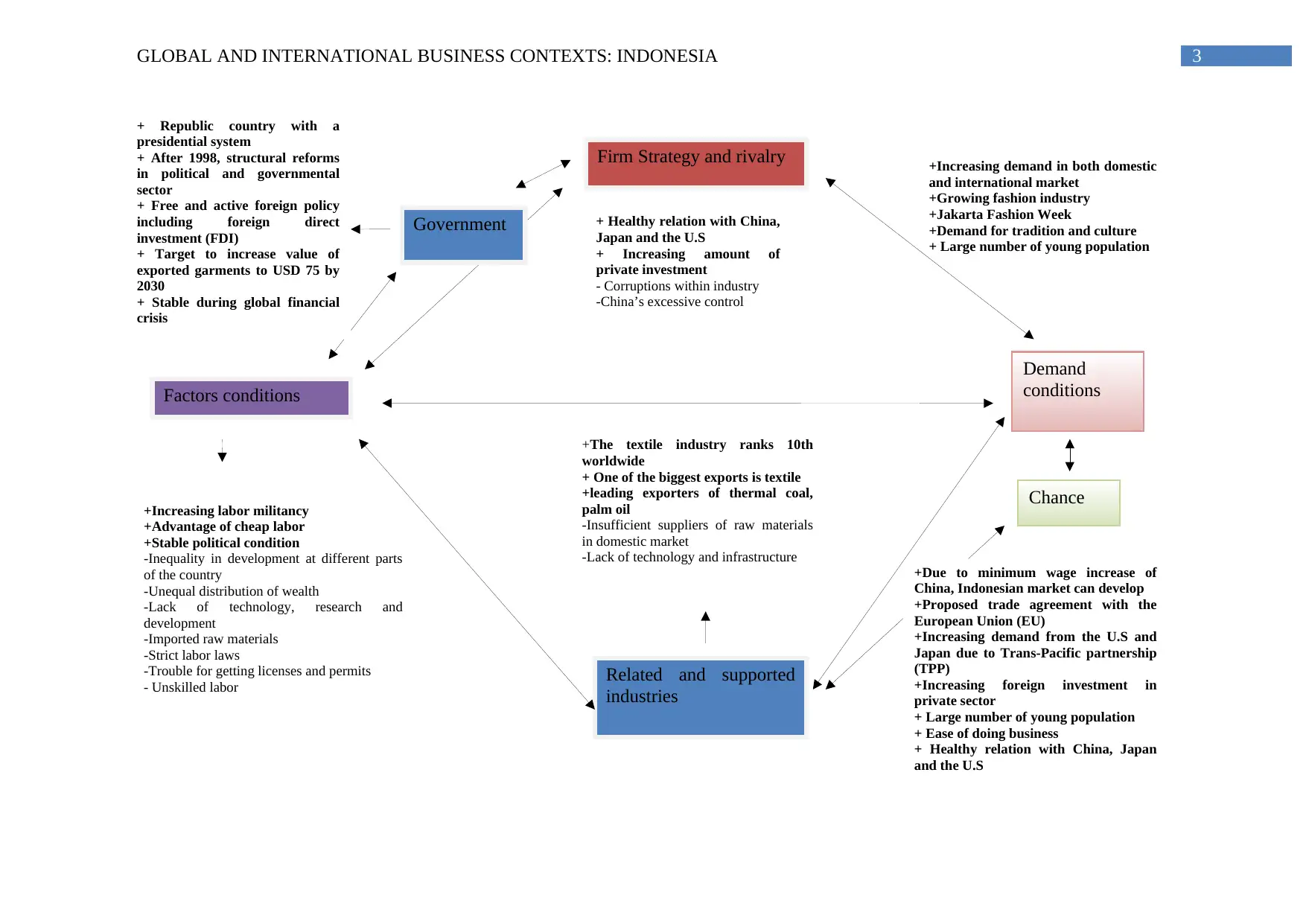
Government
Firm Strategy and rivalry
Demand
conditionsFactors conditions
Related and supported
industries
Chance
+Increasing labor militancy
+Advantage of cheap labor
+Stable political condition
-Inequality in development at different parts
of the country
-Unequal distribution of wealth
-Lack of technology, research and
development
-Imported raw materials
-Strict labor laws
-Trouble for getting licenses and permits
- Unskilled labor
+ Republic country with a
presidential system
+ After 1998, structural reforms
in political and governmental
sector
+ Free and active foreign policy
including foreign direct
investment (FDI)
+ Target to increase value of
exported garments to USD 75 by
2030
+ Stable during global financial
crisis
+ Healthy relation with China,
Japan and the U.S
+ Increasing amount of
private investment
- Corruptions within industry
-China’s excessive control
+The textile industry ranks 10th
worldwide
+ One of the biggest exports is textile
+leading exporters of thermal coal,
palm oil
-Insufficient suppliers of raw materials
in domestic market
-Lack of technology and infrastructure
+Due to minimum wage increase of
China, Indonesian market can develop
+Proposed trade agreement with the
European Union (EU)
+Increasing demand from the U.S and
Japan due to Trans-Pacific partnership
(TPP)
+Increasing foreign investment in
private sector
+ Large number of young population
+ Ease of doing business
+ Healthy relation with China, Japan
and the U.S
+Increasing demand in both domestic
and international market
+Growing fashion industry
+Jakarta Fashion Week
+Demand for tradition and culture
+ Large number of young population
3GLOBAL AND INTERNATIONAL BUSINESS CONTEXTS: INDONESIA
Firm Strategy and rivalry
Demand
conditionsFactors conditions
Related and supported
industries
Chance
+Increasing labor militancy
+Advantage of cheap labor
+Stable political condition
-Inequality in development at different parts
of the country
-Unequal distribution of wealth
-Lack of technology, research and
development
-Imported raw materials
-Strict labor laws
-Trouble for getting licenses and permits
- Unskilled labor
+ Republic country with a
presidential system
+ After 1998, structural reforms
in political and governmental
sector
+ Free and active foreign policy
including foreign direct
investment (FDI)
+ Target to increase value of
exported garments to USD 75 by
2030
+ Stable during global financial
crisis
+ Healthy relation with China,
Japan and the U.S
+ Increasing amount of
private investment
- Corruptions within industry
-China’s excessive control
+The textile industry ranks 10th
worldwide
+ One of the biggest exports is textile
+leading exporters of thermal coal,
palm oil
-Insufficient suppliers of raw materials
in domestic market
-Lack of technology and infrastructure
+Due to minimum wage increase of
China, Indonesian market can develop
+Proposed trade agreement with the
European Union (EU)
+Increasing demand from the U.S and
Japan due to Trans-Pacific partnership
(TPP)
+Increasing foreign investment in
private sector
+ Large number of young population
+ Ease of doing business
+ Healthy relation with China, Japan
and the U.S
+Increasing demand in both domestic
and international market
+Growing fashion industry
+Jakarta Fashion Week
+Demand for tradition and culture
+ Large number of young population
3GLOBAL AND INTERNATIONAL BUSINESS CONTEXTS: INDONESIA
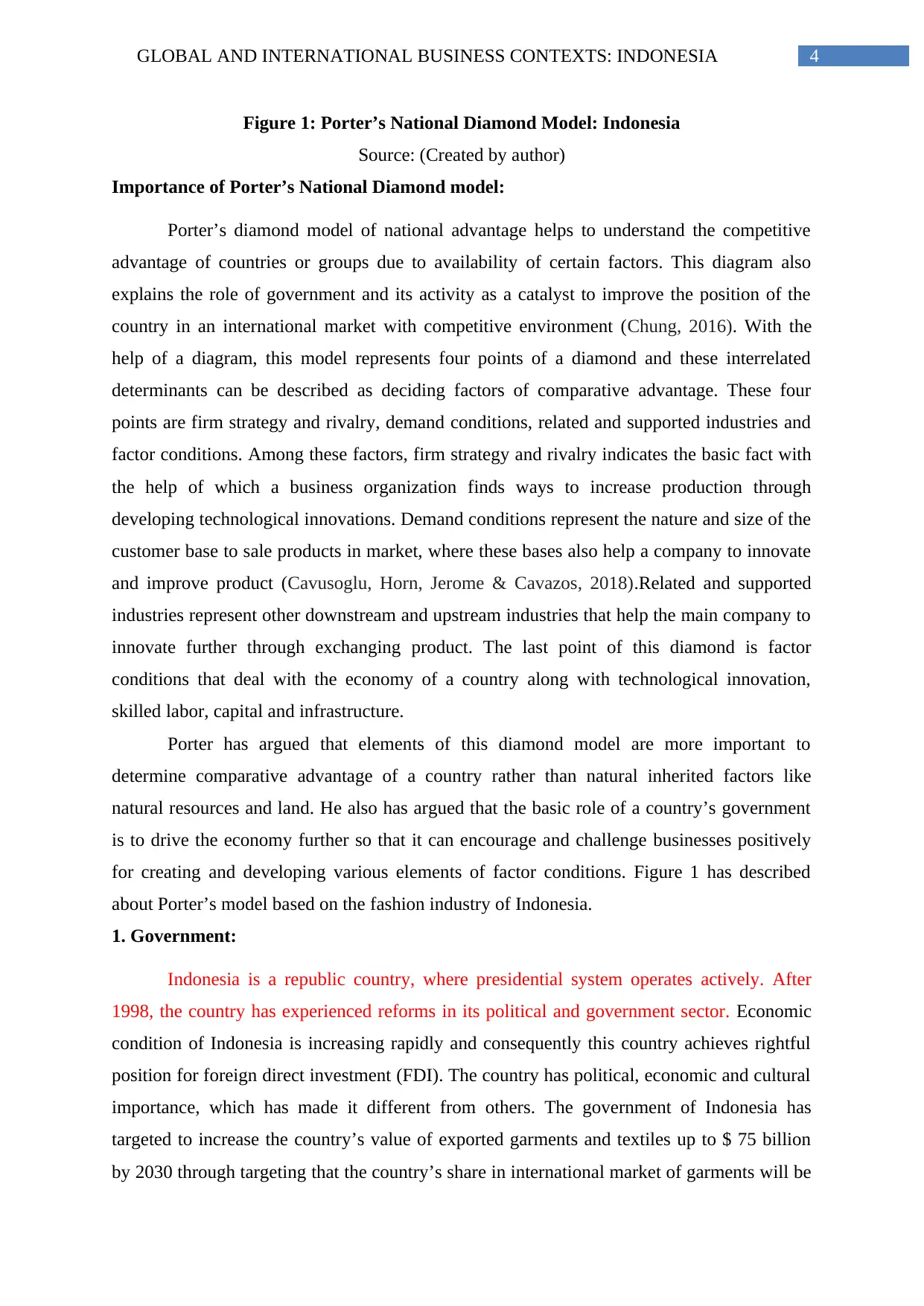
4GLOBAL AND INTERNATIONAL BUSINESS CONTEXTS: INDONESIA
Figure 1: Porter’s National Diamond Model: Indonesia
Source: (Created by author)
Importance of Porter’s National Diamond model:
Porter’s diamond model of national advantage helps to understand the competitive
advantage of countries or groups due to availability of certain factors. This diagram also
explains the role of government and its activity as a catalyst to improve the position of the
country in an international market with competitive environment (Chung, 2016). With the
help of a diagram, this model represents four points of a diamond and these interrelated
determinants can be described as deciding factors of comparative advantage. These four
points are firm strategy and rivalry, demand conditions, related and supported industries and
factor conditions. Among these factors, firm strategy and rivalry indicates the basic fact with
the help of which a business organization finds ways to increase production through
developing technological innovations. Demand conditions represent the nature and size of the
customer base to sale products in market, where these bases also help a company to innovate
and improve product (Cavusoglu, Horn, Jerome & Cavazos, 2018).Related and supported
industries represent other downstream and upstream industries that help the main company to
innovate further through exchanging product. The last point of this diamond is factor
conditions that deal with the economy of a country along with technological innovation,
skilled labor, capital and infrastructure.
Porter has argued that elements of this diamond model are more important to
determine comparative advantage of a country rather than natural inherited factors like
natural resources and land. He also has argued that the basic role of a country’s government
is to drive the economy further so that it can encourage and challenge businesses positively
for creating and developing various elements of factor conditions. Figure 1 has described
about Porter’s model based on the fashion industry of Indonesia.
1. Government:
Indonesia is a republic country, where presidential system operates actively. After
1998, the country has experienced reforms in its political and government sector. Economic
condition of Indonesia is increasing rapidly and consequently this country achieves rightful
position for foreign direct investment (FDI). The country has political, economic and cultural
importance, which has made it different from others. The government of Indonesia has
targeted to increase the country’s value of exported garments and textiles up to $ 75 billion
by 2030 through targeting that the country’s share in international market of garments will be
Figure 1: Porter’s National Diamond Model: Indonesia
Source: (Created by author)
Importance of Porter’s National Diamond model:
Porter’s diamond model of national advantage helps to understand the competitive
advantage of countries or groups due to availability of certain factors. This diagram also
explains the role of government and its activity as a catalyst to improve the position of the
country in an international market with competitive environment (Chung, 2016). With the
help of a diagram, this model represents four points of a diamond and these interrelated
determinants can be described as deciding factors of comparative advantage. These four
points are firm strategy and rivalry, demand conditions, related and supported industries and
factor conditions. Among these factors, firm strategy and rivalry indicates the basic fact with
the help of which a business organization finds ways to increase production through
developing technological innovations. Demand conditions represent the nature and size of the
customer base to sale products in market, where these bases also help a company to innovate
and improve product (Cavusoglu, Horn, Jerome & Cavazos, 2018).Related and supported
industries represent other downstream and upstream industries that help the main company to
innovate further through exchanging product. The last point of this diamond is factor
conditions that deal with the economy of a country along with technological innovation,
skilled labor, capital and infrastructure.
Porter has argued that elements of this diamond model are more important to
determine comparative advantage of a country rather than natural inherited factors like
natural resources and land. He also has argued that the basic role of a country’s government
is to drive the economy further so that it can encourage and challenge businesses positively
for creating and developing various elements of factor conditions. Figure 1 has described
about Porter’s model based on the fashion industry of Indonesia.
1. Government:
Indonesia is a republic country, where presidential system operates actively. After
1998, the country has experienced reforms in its political and government sector. Economic
condition of Indonesia is increasing rapidly and consequently this country achieves rightful
position for foreign direct investment (FDI). The country has political, economic and cultural
importance, which has made it different from others. The government of Indonesia has
targeted to increase the country’s value of exported garments and textiles up to $ 75 billion
by 2030 through targeting that the country’s share in international market of garments will be
⊘ This is a preview!⊘
Do you want full access?
Subscribe today to unlock all pages.

Trusted by 1+ million students worldwide
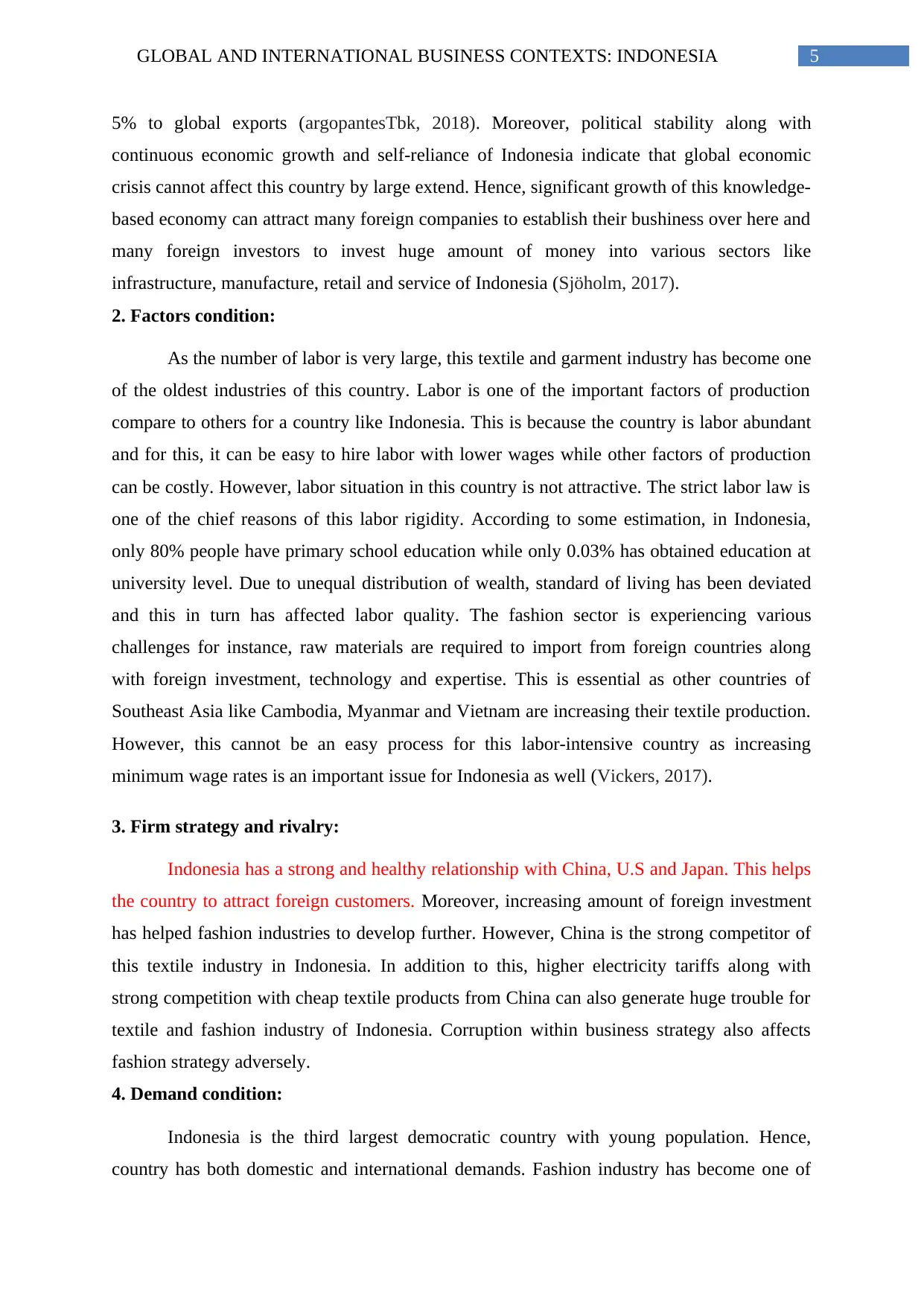
5GLOBAL AND INTERNATIONAL BUSINESS CONTEXTS: INDONESIA
5% to global exports (argopantesTbk, 2018). Moreover, political stability along with
continuous economic growth and self-reliance of Indonesia indicate that global economic
crisis cannot affect this country by large extend. Hence, significant growth of this knowledge-
based economy can attract many foreign companies to establish their bushiness over here and
many foreign investors to invest huge amount of money into various sectors like
infrastructure, manufacture, retail and service of Indonesia (Sjöholm, 2017).
2. Factors condition:
As the number of labor is very large, this textile and garment industry has become one
of the oldest industries of this country. Labor is one of the important factors of production
compare to others for a country like Indonesia. This is because the country is labor abundant
and for this, it can be easy to hire labor with lower wages while other factors of production
can be costly. However, labor situation in this country is not attractive. The strict labor law is
one of the chief reasons of this labor rigidity. According to some estimation, in Indonesia,
only 80% people have primary school education while only 0.03% has obtained education at
university level. Due to unequal distribution of wealth, standard of living has been deviated
and this in turn has affected labor quality. The fashion sector is experiencing various
challenges for instance, raw materials are required to import from foreign countries along
with foreign investment, technology and expertise. This is essential as other countries of
Southeast Asia like Cambodia, Myanmar and Vietnam are increasing their textile production.
However, this cannot be an easy process for this labor-intensive country as increasing
minimum wage rates is an important issue for Indonesia as well (Vickers, 2017).
3. Firm strategy and rivalry:
Indonesia has a strong and healthy relationship with China, U.S and Japan. This helps
the country to attract foreign customers. Moreover, increasing amount of foreign investment
has helped fashion industries to develop further. However, China is the strong competitor of
this textile industry in Indonesia. In addition to this, higher electricity tariffs along with
strong competition with cheap textile products from China can also generate huge trouble for
textile and fashion industry of Indonesia. Corruption within business strategy also affects
fashion strategy adversely.
4. Demand condition:
Indonesia is the third largest democratic country with young population. Hence,
country has both domestic and international demands. Fashion industry has become one of
5% to global exports (argopantesTbk, 2018). Moreover, political stability along with
continuous economic growth and self-reliance of Indonesia indicate that global economic
crisis cannot affect this country by large extend. Hence, significant growth of this knowledge-
based economy can attract many foreign companies to establish their bushiness over here and
many foreign investors to invest huge amount of money into various sectors like
infrastructure, manufacture, retail and service of Indonesia (Sjöholm, 2017).
2. Factors condition:
As the number of labor is very large, this textile and garment industry has become one
of the oldest industries of this country. Labor is one of the important factors of production
compare to others for a country like Indonesia. This is because the country is labor abundant
and for this, it can be easy to hire labor with lower wages while other factors of production
can be costly. However, labor situation in this country is not attractive. The strict labor law is
one of the chief reasons of this labor rigidity. According to some estimation, in Indonesia,
only 80% people have primary school education while only 0.03% has obtained education at
university level. Due to unequal distribution of wealth, standard of living has been deviated
and this in turn has affected labor quality. The fashion sector is experiencing various
challenges for instance, raw materials are required to import from foreign countries along
with foreign investment, technology and expertise. This is essential as other countries of
Southeast Asia like Cambodia, Myanmar and Vietnam are increasing their textile production.
However, this cannot be an easy process for this labor-intensive country as increasing
minimum wage rates is an important issue for Indonesia as well (Vickers, 2017).
3. Firm strategy and rivalry:
Indonesia has a strong and healthy relationship with China, U.S and Japan. This helps
the country to attract foreign customers. Moreover, increasing amount of foreign investment
has helped fashion industries to develop further. However, China is the strong competitor of
this textile industry in Indonesia. In addition to this, higher electricity tariffs along with
strong competition with cheap textile products from China can also generate huge trouble for
textile and fashion industry of Indonesia. Corruption within business strategy also affects
fashion strategy adversely.
4. Demand condition:
Indonesia is the third largest democratic country with young population. Hence,
country has both domestic and international demands. Fashion industry has become one of
Paraphrase This Document
Need a fresh take? Get an instant paraphrase of this document with our AI Paraphraser

6GLOBAL AND INTERNATIONAL BUSINESS CONTEXTS: INDONESIA
the important drivers in this creative economy of Indonesia. Since the 1970s, garment, textile
and shoes industry of this country have develop significantly and have helped the economy to
grow further. According to the Indonesian Textile Association (API), textile industry of
Indonesia has valued USD $ 15 billion in 2015 with more than 2500 garments, textiles and
shoes manufacturers that are located only in Java (Andadari, Priyanto&Haryanto, 2016).
Along with this, number of new fashion designers has also increased within this county over
the year through establishing their reputation in both national and international market. Most
of the Indonesian manufactures are situated in the Bali and Java (Natalie &Wandebori, 2018).
As a result, Bali and Jakarta have become the leading cities for fashion trend of this country.
During 2009 to 2010, Indonesian fashion industry has remained instable due to decline of
some leading players in some parts of the country. At the same time, significant increase Bali
as an important fashion city of Indonesia, has improved the rank of fashion industry of
Indonesia globally.
In this context, the role of Jakarta fashion Week can be discussed. The country
organizes this international fashion week, which is the largest fashion event in Southeast
Asia. Through this event, fashion industry of Indonesia represents its latest creation of well-
known fashion designers along with some other countries like Australia, South Korea,
Britain, Thailand and India. With the help of this annual event, Indonesia shows its fashion
labels with good quality and creativity to visitors across the world. This fashion week also
conducts some other activities, which can promote traditional cloths like batik and woven
cloths of Indonesia in world market. Moreover, this show can uplift Jakarta as one of the
important fashion cities all over the world and consequently this event can help Jakarta to
held same position with Paris, New York, London and Milan (Nasution&Rachmawan, 2018).
To develop this industry further, Indonesian government has intended to enhance creative and
tourism economy, which can further develop fashion industry among sluggish world
economy. Hence, the government has taken initiatives to promote creative economy through
attracting various startup companies and foreign companies to run their businesses in this
country. Based on the data of Industry ministry of 2015, creative economy of Indonesia has
contributed around USD $ 49.3 billion to the country’s gross domestic product (GDP).
Moreover, fashion industry of Indonesia has earned about USD $ 16 billion, which is 28.29%
of the country’s total earnings in the creative economy for the same year (Astuty, Rahayu,
Disman, &Wibowo, 2018). The chief obstacle for doing business in Indonesia is to obtain
necessary licenses and permits, which is time consuming and expensive. Thus, to start
business in this country, foreign entrepreneurs need to know about the good network between
the important drivers in this creative economy of Indonesia. Since the 1970s, garment, textile
and shoes industry of this country have develop significantly and have helped the economy to
grow further. According to the Indonesian Textile Association (API), textile industry of
Indonesia has valued USD $ 15 billion in 2015 with more than 2500 garments, textiles and
shoes manufacturers that are located only in Java (Andadari, Priyanto&Haryanto, 2016).
Along with this, number of new fashion designers has also increased within this county over
the year through establishing their reputation in both national and international market. Most
of the Indonesian manufactures are situated in the Bali and Java (Natalie &Wandebori, 2018).
As a result, Bali and Jakarta have become the leading cities for fashion trend of this country.
During 2009 to 2010, Indonesian fashion industry has remained instable due to decline of
some leading players in some parts of the country. At the same time, significant increase Bali
as an important fashion city of Indonesia, has improved the rank of fashion industry of
Indonesia globally.
In this context, the role of Jakarta fashion Week can be discussed. The country
organizes this international fashion week, which is the largest fashion event in Southeast
Asia. Through this event, fashion industry of Indonesia represents its latest creation of well-
known fashion designers along with some other countries like Australia, South Korea,
Britain, Thailand and India. With the help of this annual event, Indonesia shows its fashion
labels with good quality and creativity to visitors across the world. This fashion week also
conducts some other activities, which can promote traditional cloths like batik and woven
cloths of Indonesia in world market. Moreover, this show can uplift Jakarta as one of the
important fashion cities all over the world and consequently this event can help Jakarta to
held same position with Paris, New York, London and Milan (Nasution&Rachmawan, 2018).
To develop this industry further, Indonesian government has intended to enhance creative and
tourism economy, which can further develop fashion industry among sluggish world
economy. Hence, the government has taken initiatives to promote creative economy through
attracting various startup companies and foreign companies to run their businesses in this
country. Based on the data of Industry ministry of 2015, creative economy of Indonesia has
contributed around USD $ 49.3 billion to the country’s gross domestic product (GDP).
Moreover, fashion industry of Indonesia has earned about USD $ 16 billion, which is 28.29%
of the country’s total earnings in the creative economy for the same year (Astuty, Rahayu,
Disman, &Wibowo, 2018). The chief obstacle for doing business in Indonesia is to obtain
necessary licenses and permits, which is time consuming and expensive. Thus, to start
business in this country, foreign entrepreneurs need to know about the good network between
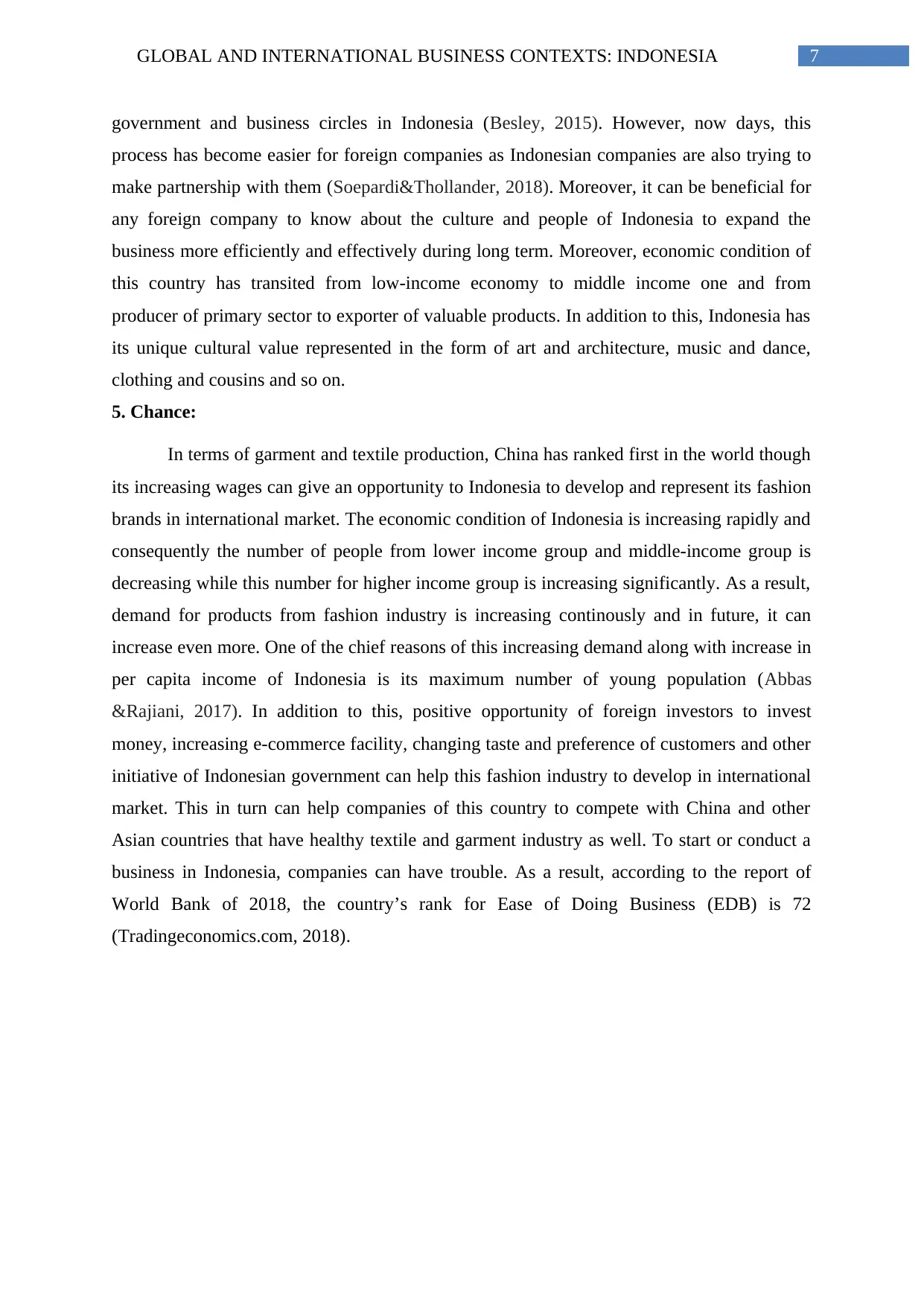
7GLOBAL AND INTERNATIONAL BUSINESS CONTEXTS: INDONESIA
government and business circles in Indonesia (Besley, 2015). However, now days, this
process has become easier for foreign companies as Indonesian companies are also trying to
make partnership with them (Soepardi&Thollander, 2018). Moreover, it can be beneficial for
any foreign company to know about the culture and people of Indonesia to expand the
business more efficiently and effectively during long term. Moreover, economic condition of
this country has transited from low-income economy to middle income one and from
producer of primary sector to exporter of valuable products. In addition to this, Indonesia has
its unique cultural value represented in the form of art and architecture, music and dance,
clothing and cousins and so on.
5. Chance:
In terms of garment and textile production, China has ranked first in the world though
its increasing wages can give an opportunity to Indonesia to develop and represent its fashion
brands in international market. The economic condition of Indonesia is increasing rapidly and
consequently the number of people from lower income group and middle-income group is
decreasing while this number for higher income group is increasing significantly. As a result,
demand for products from fashion industry is increasing continously and in future, it can
increase even more. One of the chief reasons of this increasing demand along with increase in
per capita income of Indonesia is its maximum number of young population (Abbas
&Rajiani, 2017). In addition to this, positive opportunity of foreign investors to invest
money, increasing e-commerce facility, changing taste and preference of customers and other
initiative of Indonesian government can help this fashion industry to develop in international
market. This in turn can help companies of this country to compete with China and other
Asian countries that have healthy textile and garment industry as well. To start or conduct a
business in Indonesia, companies can have trouble. As a result, according to the report of
World Bank of 2018, the country’s rank for Ease of Doing Business (EDB) is 72
(Tradingeconomics.com, 2018).
government and business circles in Indonesia (Besley, 2015). However, now days, this
process has become easier for foreign companies as Indonesian companies are also trying to
make partnership with them (Soepardi&Thollander, 2018). Moreover, it can be beneficial for
any foreign company to know about the culture and people of Indonesia to expand the
business more efficiently and effectively during long term. Moreover, economic condition of
this country has transited from low-income economy to middle income one and from
producer of primary sector to exporter of valuable products. In addition to this, Indonesia has
its unique cultural value represented in the form of art and architecture, music and dance,
clothing and cousins and so on.
5. Chance:
In terms of garment and textile production, China has ranked first in the world though
its increasing wages can give an opportunity to Indonesia to develop and represent its fashion
brands in international market. The economic condition of Indonesia is increasing rapidly and
consequently the number of people from lower income group and middle-income group is
decreasing while this number for higher income group is increasing significantly. As a result,
demand for products from fashion industry is increasing continously and in future, it can
increase even more. One of the chief reasons of this increasing demand along with increase in
per capita income of Indonesia is its maximum number of young population (Abbas
&Rajiani, 2017). In addition to this, positive opportunity of foreign investors to invest
money, increasing e-commerce facility, changing taste and preference of customers and other
initiative of Indonesian government can help this fashion industry to develop in international
market. This in turn can help companies of this country to compete with China and other
Asian countries that have healthy textile and garment industry as well. To start or conduct a
business in Indonesia, companies can have trouble. As a result, according to the report of
World Bank of 2018, the country’s rank for Ease of Doing Business (EDB) is 72
(Tradingeconomics.com, 2018).
⊘ This is a preview!⊘
Do you want full access?
Subscribe today to unlock all pages.

Trusted by 1+ million students worldwide
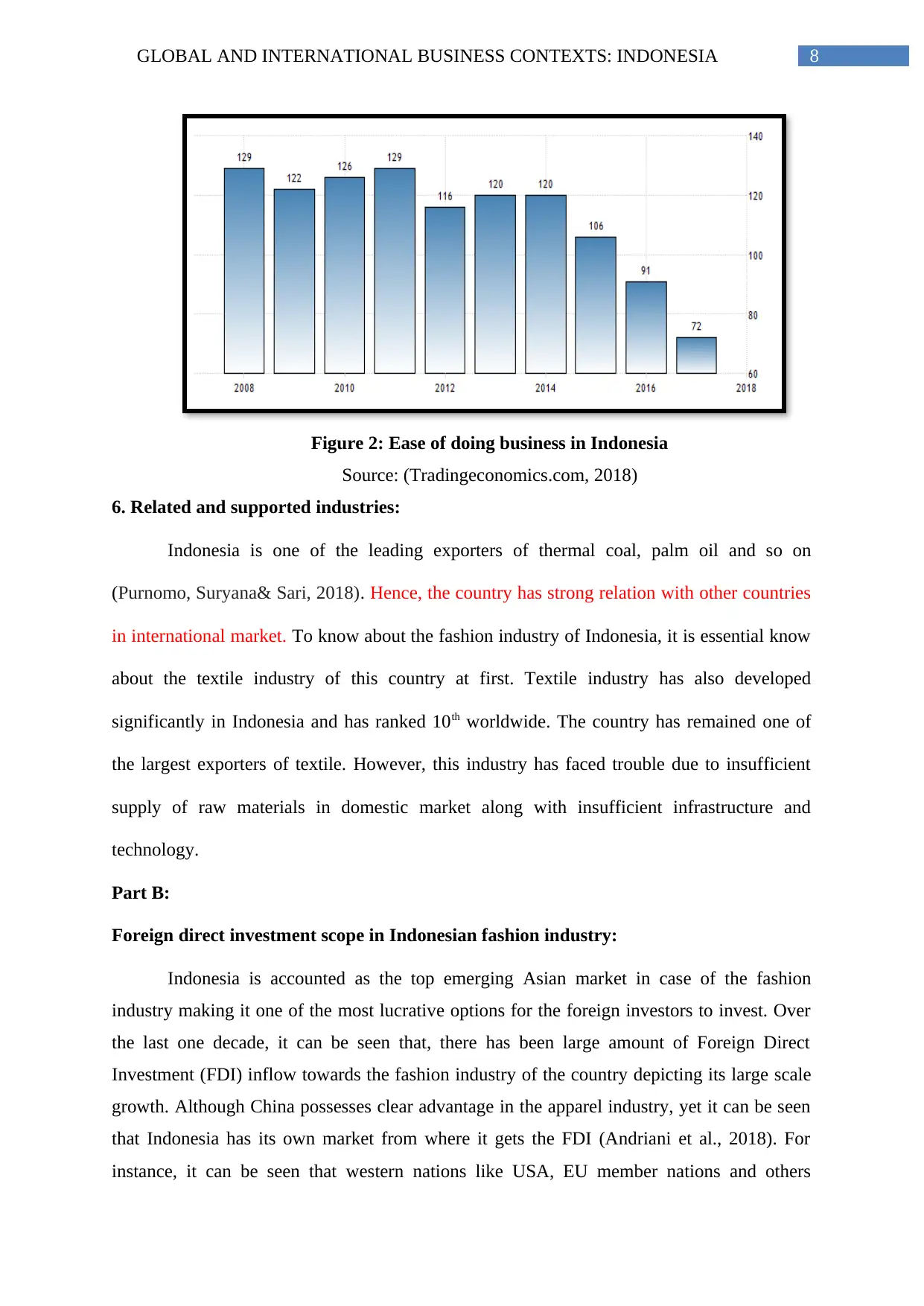
8GLOBAL AND INTERNATIONAL BUSINESS CONTEXTS: INDONESIA
Figure 2: Ease of doing business in Indonesia
Source: (Tradingeconomics.com, 2018)
6. Related and supported industries:
Indonesia is one of the leading exporters of thermal coal, palm oil and so on
(Purnomo, Suryana& Sari, 2018). Hence, the country has strong relation with other countries
in international market. To know about the fashion industry of Indonesia, it is essential know
about the textile industry of this country at first. Textile industry has also developed
significantly in Indonesia and has ranked 10th worldwide. The country has remained one of
the largest exporters of textile. However, this industry has faced trouble due to insufficient
supply of raw materials in domestic market along with insufficient infrastructure and
technology.
Part B:
Foreign direct investment scope in Indonesian fashion industry:
Indonesia is accounted as the top emerging Asian market in case of the fashion
industry making it one of the most lucrative options for the foreign investors to invest. Over
the last one decade, it can be seen that, there has been large amount of Foreign Direct
Investment (FDI) inflow towards the fashion industry of the country depicting its large scale
growth. Although China possesses clear advantage in the apparel industry, yet it can be seen
that Indonesia has its own market from where it gets the FDI (Andriani et al., 2018). For
instance, it can be seen that western nations like USA, EU member nations and others
Figure 2: Ease of doing business in Indonesia
Source: (Tradingeconomics.com, 2018)
6. Related and supported industries:
Indonesia is one of the leading exporters of thermal coal, palm oil and so on
(Purnomo, Suryana& Sari, 2018). Hence, the country has strong relation with other countries
in international market. To know about the fashion industry of Indonesia, it is essential know
about the textile industry of this country at first. Textile industry has also developed
significantly in Indonesia and has ranked 10th worldwide. The country has remained one of
the largest exporters of textile. However, this industry has faced trouble due to insufficient
supply of raw materials in domestic market along with insufficient infrastructure and
technology.
Part B:
Foreign direct investment scope in Indonesian fashion industry:
Indonesia is accounted as the top emerging Asian market in case of the fashion
industry making it one of the most lucrative options for the foreign investors to invest. Over
the last one decade, it can be seen that, there has been large amount of Foreign Direct
Investment (FDI) inflow towards the fashion industry of the country depicting its large scale
growth. Although China possesses clear advantage in the apparel industry, yet it can be seen
that Indonesia has its own market from where it gets the FDI (Andriani et al., 2018). For
instance, it can be seen that western nations like USA, EU member nations and others
Paraphrase This Document
Need a fresh take? Get an instant paraphrase of this document with our AI Paraphraser
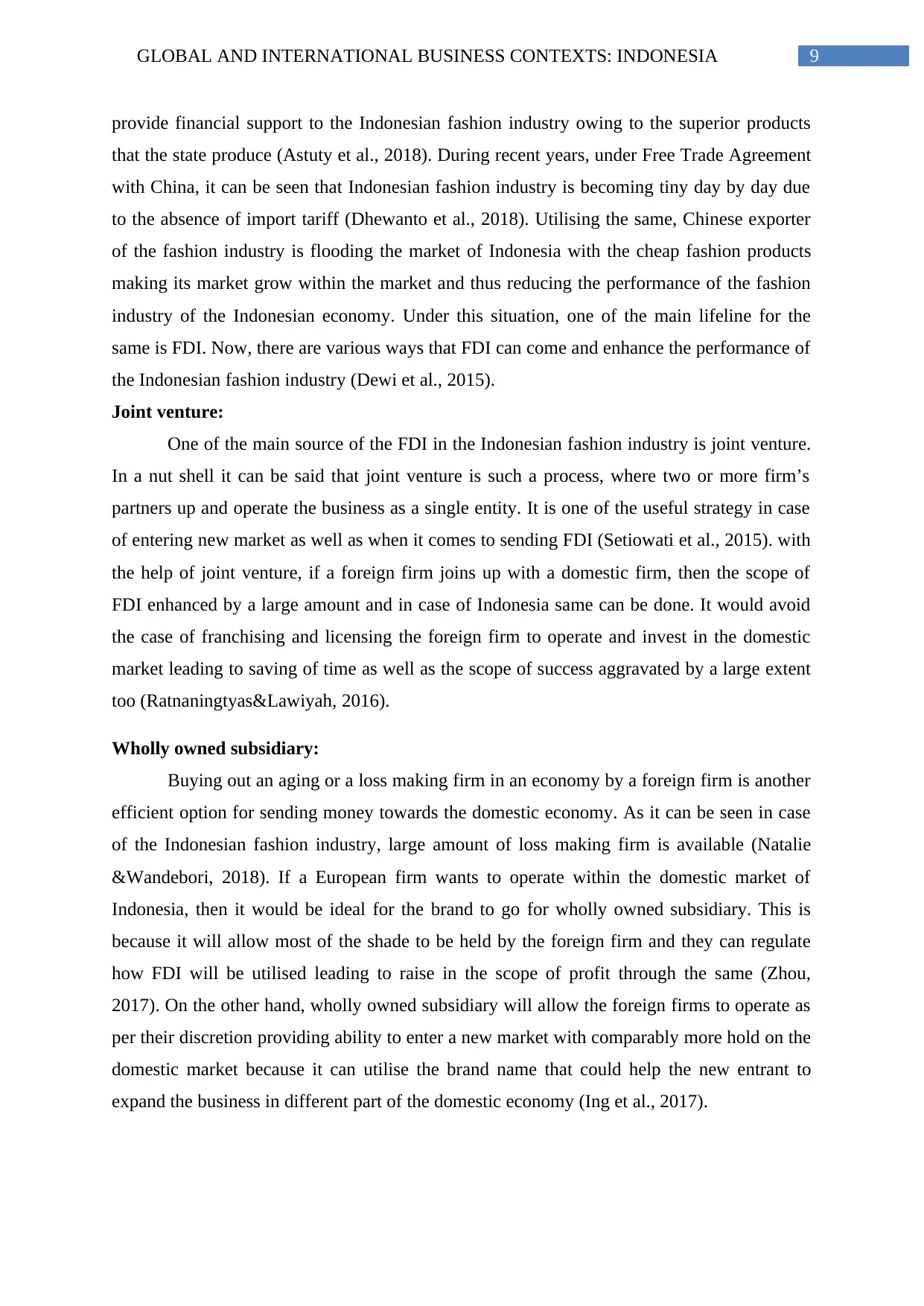
9GLOBAL AND INTERNATIONAL BUSINESS CONTEXTS: INDONESIA
provide financial support to the Indonesian fashion industry owing to the superior products
that the state produce (Astuty et al., 2018). During recent years, under Free Trade Agreement
with China, it can be seen that Indonesian fashion industry is becoming tiny day by day due
to the absence of import tariff (Dhewanto et al., 2018). Utilising the same, Chinese exporter
of the fashion industry is flooding the market of Indonesia with the cheap fashion products
making its market grow within the market and thus reducing the performance of the fashion
industry of the Indonesian economy. Under this situation, one of the main lifeline for the
same is FDI. Now, there are various ways that FDI can come and enhance the performance of
the Indonesian fashion industry (Dewi et al., 2015).
Joint venture:
One of the main source of the FDI in the Indonesian fashion industry is joint venture.
In a nut shell it can be said that joint venture is such a process, where two or more firm’s
partners up and operate the business as a single entity. It is one of the useful strategy in case
of entering new market as well as when it comes to sending FDI (Setiowati et al., 2015). with
the help of joint venture, if a foreign firm joins up with a domestic firm, then the scope of
FDI enhanced by a large amount and in case of Indonesia same can be done. It would avoid
the case of franchising and licensing the foreign firm to operate and invest in the domestic
market leading to saving of time as well as the scope of success aggravated by a large extent
too (Ratnaningtyas&Lawiyah, 2016).
Wholly owned subsidiary:
Buying out an aging or a loss making firm in an economy by a foreign firm is another
efficient option for sending money towards the domestic economy. As it can be seen in case
of the Indonesian fashion industry, large amount of loss making firm is available (Natalie
&Wandebori, 2018). If a European firm wants to operate within the domestic market of
Indonesia, then it would be ideal for the brand to go for wholly owned subsidiary. This is
because it will allow most of the shade to be held by the foreign firm and they can regulate
how FDI will be utilised leading to raise in the scope of profit through the same (Zhou,
2017). On the other hand, wholly owned subsidiary will allow the foreign firms to operate as
per their discretion providing ability to enter a new market with comparably more hold on the
domestic market because it can utilise the brand name that could help the new entrant to
expand the business in different part of the domestic economy (Ing et al., 2017).
provide financial support to the Indonesian fashion industry owing to the superior products
that the state produce (Astuty et al., 2018). During recent years, under Free Trade Agreement
with China, it can be seen that Indonesian fashion industry is becoming tiny day by day due
to the absence of import tariff (Dhewanto et al., 2018). Utilising the same, Chinese exporter
of the fashion industry is flooding the market of Indonesia with the cheap fashion products
making its market grow within the market and thus reducing the performance of the fashion
industry of the Indonesian economy. Under this situation, one of the main lifeline for the
same is FDI. Now, there are various ways that FDI can come and enhance the performance of
the Indonesian fashion industry (Dewi et al., 2015).
Joint venture:
One of the main source of the FDI in the Indonesian fashion industry is joint venture.
In a nut shell it can be said that joint venture is such a process, where two or more firm’s
partners up and operate the business as a single entity. It is one of the useful strategy in case
of entering new market as well as when it comes to sending FDI (Setiowati et al., 2015). with
the help of joint venture, if a foreign firm joins up with a domestic firm, then the scope of
FDI enhanced by a large amount and in case of Indonesia same can be done. It would avoid
the case of franchising and licensing the foreign firm to operate and invest in the domestic
market leading to saving of time as well as the scope of success aggravated by a large extent
too (Ratnaningtyas&Lawiyah, 2016).
Wholly owned subsidiary:
Buying out an aging or a loss making firm in an economy by a foreign firm is another
efficient option for sending money towards the domestic economy. As it can be seen in case
of the Indonesian fashion industry, large amount of loss making firm is available (Natalie
&Wandebori, 2018). If a European firm wants to operate within the domestic market of
Indonesia, then it would be ideal for the brand to go for wholly owned subsidiary. This is
because it will allow most of the shade to be held by the foreign firm and they can regulate
how FDI will be utilised leading to raise in the scope of profit through the same (Zhou,
2017). On the other hand, wholly owned subsidiary will allow the foreign firms to operate as
per their discretion providing ability to enter a new market with comparably more hold on the
domestic market because it can utilise the brand name that could help the new entrant to
expand the business in different part of the domestic economy (Ing et al., 2017).
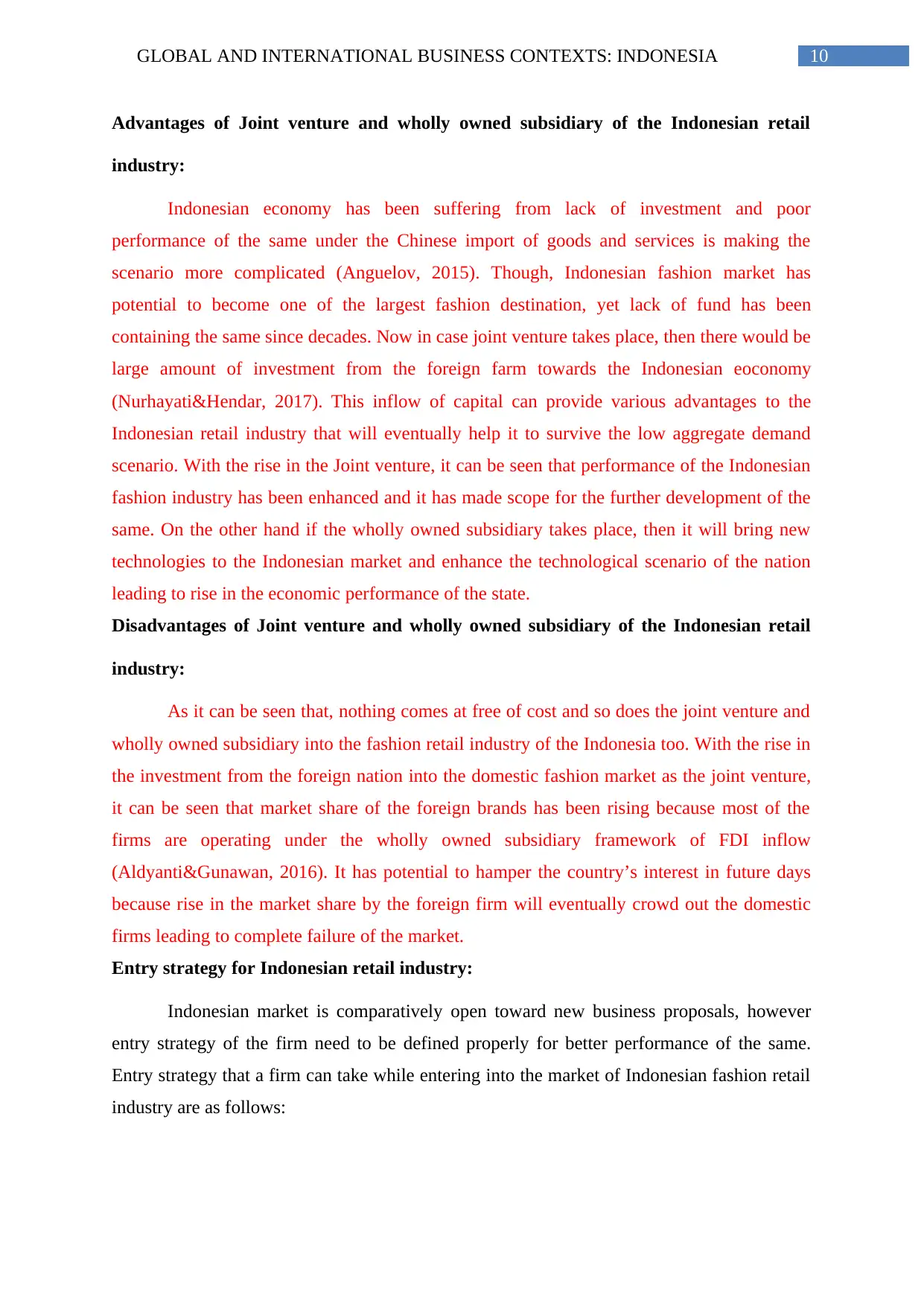
10GLOBAL AND INTERNATIONAL BUSINESS CONTEXTS: INDONESIA
Advantages of Joint venture and wholly owned subsidiary of the Indonesian retail
industry:
Indonesian economy has been suffering from lack of investment and poor
performance of the same under the Chinese import of goods and services is making the
scenario more complicated (Anguelov, 2015). Though, Indonesian fashion market has
potential to become one of the largest fashion destination, yet lack of fund has been
containing the same since decades. Now in case joint venture takes place, then there would be
large amount of investment from the foreign farm towards the Indonesian eoconomy
(Nurhayati&Hendar, 2017). This inflow of capital can provide various advantages to the
Indonesian retail industry that will eventually help it to survive the low aggregate demand
scenario. With the rise in the Joint venture, it can be seen that performance of the Indonesian
fashion industry has been enhanced and it has made scope for the further development of the
same. On the other hand if the wholly owned subsidiary takes place, then it will bring new
technologies to the Indonesian market and enhance the technological scenario of the nation
leading to rise in the economic performance of the state.
Disadvantages of Joint venture and wholly owned subsidiary of the Indonesian retail
industry:
As it can be seen that, nothing comes at free of cost and so does the joint venture and
wholly owned subsidiary into the fashion retail industry of the Indonesia too. With the rise in
the investment from the foreign nation into the domestic fashion market as the joint venture,
it can be seen that market share of the foreign brands has been rising because most of the
firms are operating under the wholly owned subsidiary framework of FDI inflow
(Aldyanti&Gunawan, 2016). It has potential to hamper the country’s interest in future days
because rise in the market share by the foreign firm will eventually crowd out the domestic
firms leading to complete failure of the market.
Entry strategy for Indonesian retail industry:
Indonesian market is comparatively open toward new business proposals, however
entry strategy of the firm need to be defined properly for better performance of the same.
Entry strategy that a firm can take while entering into the market of Indonesian fashion retail
industry are as follows:
Advantages of Joint venture and wholly owned subsidiary of the Indonesian retail
industry:
Indonesian economy has been suffering from lack of investment and poor
performance of the same under the Chinese import of goods and services is making the
scenario more complicated (Anguelov, 2015). Though, Indonesian fashion market has
potential to become one of the largest fashion destination, yet lack of fund has been
containing the same since decades. Now in case joint venture takes place, then there would be
large amount of investment from the foreign farm towards the Indonesian eoconomy
(Nurhayati&Hendar, 2017). This inflow of capital can provide various advantages to the
Indonesian retail industry that will eventually help it to survive the low aggregate demand
scenario. With the rise in the Joint venture, it can be seen that performance of the Indonesian
fashion industry has been enhanced and it has made scope for the further development of the
same. On the other hand if the wholly owned subsidiary takes place, then it will bring new
technologies to the Indonesian market and enhance the technological scenario of the nation
leading to rise in the economic performance of the state.
Disadvantages of Joint venture and wholly owned subsidiary of the Indonesian retail
industry:
As it can be seen that, nothing comes at free of cost and so does the joint venture and
wholly owned subsidiary into the fashion retail industry of the Indonesia too. With the rise in
the investment from the foreign nation into the domestic fashion market as the joint venture,
it can be seen that market share of the foreign brands has been rising because most of the
firms are operating under the wholly owned subsidiary framework of FDI inflow
(Aldyanti&Gunawan, 2016). It has potential to hamper the country’s interest in future days
because rise in the market share by the foreign firm will eventually crowd out the domestic
firms leading to complete failure of the market.
Entry strategy for Indonesian retail industry:
Indonesian market is comparatively open toward new business proposals, however
entry strategy of the firm need to be defined properly for better performance of the same.
Entry strategy that a firm can take while entering into the market of Indonesian fashion retail
industry are as follows:
⊘ This is a preview!⊘
Do you want full access?
Subscribe today to unlock all pages.

Trusted by 1+ million students worldwide
1 out of 18
Related Documents
Your All-in-One AI-Powered Toolkit for Academic Success.
+13062052269
info@desklib.com
Available 24*7 on WhatsApp / Email
![[object Object]](/_next/static/media/star-bottom.7253800d.svg)
Unlock your academic potential
Copyright © 2020–2025 A2Z Services. All Rights Reserved. Developed and managed by ZUCOL.





